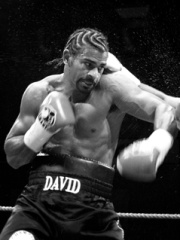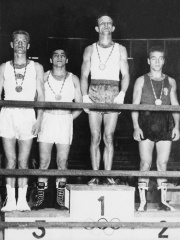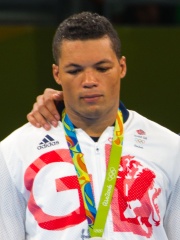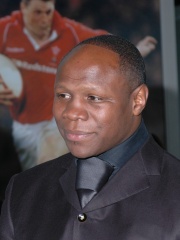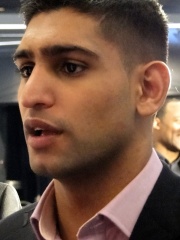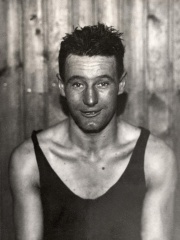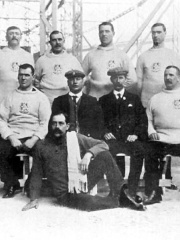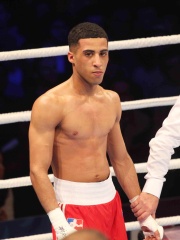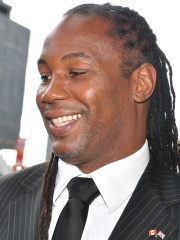
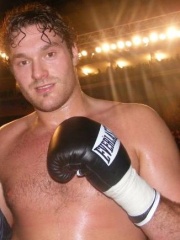
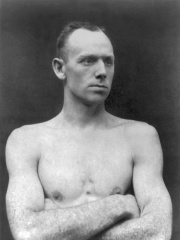




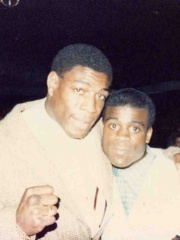
The Most Famous
BOXERS from United Kingdom
This page contains a list of the greatest British Boxers. The pantheon dataset contains 496 Boxers, 30 of which were born in United Kingdom. This makes United Kingdom the birth place of the 2nd most number of Boxers.
Top 10
The following people are considered by Pantheon to be the top 10 most legendary British Boxers of all time. This list of famous British Boxers is sorted by HPI (Historical Popularity Index), a metric that aggregates information on a biography’s online popularity. Visit the rankings page to view the entire list of British Boxers.

1. Lennox Lewis (b. 1965)
With an HPI of 57.13, Lennox Lewis is the most famous British Boxer. His biography has been translated into 39 different languages on wikipedia.
Lennox Claudius Lewis (born 2 September 1965) is a boxing commentator and former professional boxer who competed from 1989 to 2003. He is a three-time world heavyweight champion, a two-time lineal champion, and the last heavyweight to hold the undisputed championship. Holding dual British and Canadian citizenship, Lewis represented Canada as an amateur at the 1984 and 1988 Olympics; in the latter, he won a gold medal in the super-heavyweight division. In his first three years as a professional, Lewis won several regional heavyweight championships, including the European, British, and Commonwealth titles. After winning his first 21 fights, he defeated Donovan Ruddock in 1992 to take over the number one position in the WBC rankings. He was declared WBC heavyweight champion later that year after Riddick Bowe gave up the title refusing to defend it against Lewis. He defended the title three times before an upset knockout loss to Oliver McCall in 1994. Lewis avenged the loss in a 1997 rematch to win back the vacant WBC title. Two fights against Evander Holyfield in 1999 (the first ending in a controversial draw) saw Lewis become undisputed heavyweight champion by unifying his WBC title with Holyfield's WBA and IBF titles, as well as the vacant IBO title. In 2000, the WBA stripped Lewis of his title when he chose to face Michael Grant instead of mandatory challenger John Ruiz. Similarly, the IBF stripped Lewis of their title in 2002 when he chose not to face their mandatory challenger Chris Byrd. Lewis was knocked out by Hasim Rahman in an upset in 2001, but this defeat was avenged later in the year. In 2002, Lewis defeated Mike Tyson in one of the most highly anticipated fights in boxing history. Prior to the event, Lewis was awarded the Ring magazine heavyweight title, which had been discontinued in the late 1980s. In what would be his final fight, Lewis defeated Vitali Klitschko in a brutal and bloody encounter in 2003. He vacated his remaining titles and retired from boxing in 2004. Lewis often refers to himself as "the pugilist specialist". He is 6 ft 5 in (1.96 m) tall, with an 84 in (213 cm) reach, and weighed about 245 lb (111 kg) during his boxing prime. He is regarded by many as one of the greatest heavyweight boxers of all time, and one of the greatest British fighters of all time.

2. Tyson Fury (b. 1988)
With an HPI of 50.55, Tyson Fury is the 2nd most famous British Boxer. His biography has been translated into 35 different languages.
Tyson Luke Fury (born 12 August 1988) is a British professional boxer. He has held the World Boxing Council (WBC) heavyweight title since 2020. Previously, he held the unified heavyweight titles from 2015 to 2016, and the Ring magazine title twice between 2015 and 2022. He also held the International Boxing Organization (IBO) title during his first reign as champion. At regional level, he has held multiple heavyweight championships, including the British title twice between 2011 and 2015; the European title from 2014 to 2015; and the Commonwealth title from 2011 to 2012. As an amateur, he won a bronze medal at the 2006 World Junior Championships; gold at the 2007 EU Junior Championships; silver at the 2007 European Junior Championships; and won the ABA super-heavyweight title in 2008. In 2015, his victorious fight against Wladimir Klitschko was named Upset of the Year and earned him Fighter of the Year by The Ring. In 2018, his drawn fight against Deontay Wilder was named Round of the Year and earned him Comeback of the Year by The Ring. In 2020, with his defeat of Deontay Wilder, Fury became the third heavyweight, after Floyd Patterson and Muhammad Ali, to hold The Ring magazine title twice, and is widely considered by media outlets to be the lineal heavyweight champion. In 2021, his trilogy fight against Wilder was named Fight of the Year by The Ring. As of December 2022, Fury is ranked as the world's best active heavyweight by BoxRec and ESPN, he is also ranked sixth pound-for-pound by ESPN and the Boxing Writers Association of America, and seventh by the Transnational Boxing Rankings Board.

3. Bob Fitzsimmons (1863 - 1917)
With an HPI of 50.43, Bob Fitzsimmons is the 3rd most famous British Boxer. His biography has been translated into 21 different languages.
Robert James Fitzsimmons (26 May 1862 – 22 October 1917) was a British professional boxer who was the sport's first three-division world champion. He also achieved fame for beating Gentleman Jim Corbett (the man who beat John L. Sullivan), and he is in The Guinness Book of World Records as the lightest heavyweight champion, weighing just 167 pounds when he won the title. Nicknamed Ruby Robert and The Freckled Wonder, he took pride in his lack of scars and appeared in the ring wearing heavy woollen underwear to conceal the disparity between his trunk and leg-development. Considered one of the hardest punchers in boxing history, Fitzsimmons is ranked as No. 8 on The Ring magazine's list of 100 greatest punchers of all time.

4. Frederick Grace (1884 - 1964)
With an HPI of 49.47, Frederick Grace is the 4th most famous British Boxer. His biography has been translated into 16 different languages.
Frederick Grace (29 February 1884 – 23 July 1964) was a lightweight boxer. He fought as Fred Grace and at the 1908 Olympic Games he became Olympic champion, defeating Matt Wells along the way. He also became the British and European amateur champion.
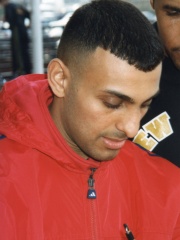
5. Naseem Hamed (b. 1974)
With an HPI of 48.02, Naseem Hamed is the 5th most famous British Boxer. His biography has been translated into 19 different languages.
Naseem Hamed (Arabic: نسيم حميد; born 12 February 1974), nicknamed Prince Naseem and Naz, is a British former professional boxer who competed from 1992 to 2002. He held multiple featherweight world championships between 1995 and 2000, and reigned as lineal champion from 1998 to 2001. He also held the International Boxing Organization (IBO) featherweight title from 2002 to 2003, and the European bantamweight title from 1994 to 1995. In 2015, he was inducted into the International Boxing Hall of Fame. The Ring magazine retroactively awarded Hamed their featherweight title in 2019 to acknowledge his dominance of the division and the multiple champions he defeated; he is the only former world champion in any division thus far to receive this honour.Hamed was known for his unconventional boxing antics and spectacular ring entrances which included entering the ring on a flying carpet, a lift, and a palanquin, as well as re-enacting the video of Michael Jackson's Thriller, and wearing a Halloween mask. He was also known for his front somersault over the top rope into the ring, his highly athletic and hard-hitting southpaw boxing style, and formidable one-punch knockout power, having finished his career with a knockout-to-win ratio of 84%. With his cocky persona and high-profile bouts he was a prominent figure in 1990s British pop culture, while Sean Ingle in The Guardian writes, "in his prime, Hamed was a global superstar". A headliner on both sides of the Atlantic, Dan Rafael of ESPN writes, "one of the biggest stars in the sport, the guy sold out arenas before his opponent was even named."As of August 2023, BoxRec ranks Hamed as the 22nd greatest European pound-for-pound boxer of all time and the 12th greatest British fighter of all time. In 2016, ESPN ranked Hamed at number 22 on its list of the top 25 fighters, pound for pound, of the last 25 years. World Boxing, a sister publication of The Ring magazine, ranked Hamed the 11th greatest British boxer of all time, and Gareth A. Davies of The Telegraph ranked him 10th. The Ring also ranked Hamed the 46th greatest puncher of all time.

6. Henry Cooper (1934 - 2011)
With an HPI of 47.89, Henry Cooper is the 6th most famous British Boxer. His biography has been translated into 20 different languages.
Sir Henry Cooper (3 May 1934 – 1 May 2011) was an English heavyweight boxer. He was undefeated in British and Commonwealth heavyweight championship contests for twelve years and held the European heavyweight title for three years. In a 1963 fight against a young Cassius Clay (later known as Muhammad Ali), he knocked Clay down in Round 4, before the fight was stopped in Round 5 because of a cut to Cooper's eye. In 1966 he fought Ali for a second time. Ali was then world heavyweight champion. However, Cooper again lost due to an eye injury. Cooper was twice voted BBC Sports Personality of the Year and, after retiring in 1971 following a controversial loss to Joe Bugner, remained a popular public figure. He is the only British boxer to have been awarded a knighthood.

7. Ronald Rawson (1892 - 1952)
With an HPI of 47.53, Ronald Rawson is the 7th most famous British Boxer. His biography has been translated into 21 different languages.
Ronald Rawson Rawson (17 June 1892 – 30 March 1952) was an English heavyweight professional boxer, who won a gold medal in Boxing at the 1920 Summer Olympics for Great Britain.

8. Anthony Joshua (b. 1989)
With an HPI of 46.64, Anthony Joshua is the 8th most famous British Boxer. His biography has been translated into 41 different languages.
Anthony Oluwafemi Olaseni Joshua (born 15 October 1989) is a British professional boxer. He is a two-time former unified world heavyweight champion, having held the World Boxing Association (WBA) (Super version), International Boxing Federation (IBF), and World Boxing Organization (WBO) titles twice between 2016 and 2021. He also held the International Boxing Organization (IBO) title twice during that reign. At regional level, he held the British and Commonwealth heavyweight titles from 2015 to 2016. As an amateur, Joshua represented England at the 2011 World Championships in the super-heavyweight division, winning a silver medal. He also represented Great Britain at the 2012 Olympics, winning gold. In 2014, a year after turning professional, he was named Prospect of the Year by The Ring magazine. In 2017, his victorious fight against Wladimir Klitschko was named Fight of the Year by The Ring and the Boxing Writers Association of America. Joshua is the second English boxer, after James DeGale, to win both a gold medal at the Olympics and a world title by a major professional sanctioning body, as well as the first English heavyweight to do so. As of October 2022, Joshua is ranked as the world's second-best active heavyweight by BoxRec, third by The Ring, and fourth by Transnational Boxing Rankings Board and ESPN, as well as the sixth-best active boxer, pound for pound, by BoxRec. He has been ranked by BoxRec as among the world's top 10 heavyweights since 2014, and was ranked at No. 1 at the conclusion of 2016 and 2017. Joshua's knockout-to-win percentage stands at 88%, with an overall knockout percentage of 58% in world heavyweight title fights.

9. Frank Bruno (b. 1961)
With an HPI of 43.59, Frank Bruno is the 9th most famous British Boxer. His biography has been translated into 22 different languages.
Franklin Roy Bruno (born 16 November 1961) is a British former professional boxer who competed from 1982 to 1996. He had a highly publicised and eventful career. The pinnacle of Bruno's boxing career was winning the WBC heavyweight title from Oliver McCall at Wembley Stadium in 1995, in what was his fourth world championship challenge. Bruno faced multiple top-rated heavyweights throughout his career, including two defeats against Mike Tyson in 1989 and 1996, and a defeat against fellow Briton Lennox Lewis in 1993. Bruno was also known for his exceptional punching power, scoring 38 knockouts in 40 wins and giving him a 95% knockout-to-win ratio; his overall knockout percentage was 84.44%. Bruno was ranked among BoxRec's 10 best heavyweights in the world twelve times, reaching his career-high ranking of world no. 3 at the conclusion of 1984. Like Henry Cooper before him, in retirement Bruno was a celebrity with the British public. His post-boxing life included well-documented struggles with mental health.
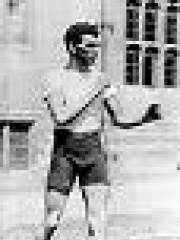
10. Harry Mallin (1892 - 1969)
With an HPI of 42.70, Harry Mallin is the 10th most famous British Boxer. His biography has been translated into 20 different languages.
Henry William Mallin (1 June 1892 – 8 November 1969) was an English middleweight amateur boxer. He came originally from Hackney Wick, his younger brother was the Olympic boxer Fred Mallin. He lived in Dartmouth Park, North London and was a police officer with the Metropolitan Police.
People
Pantheon has 34 people classified as British boxers born between 1863 and 1992. Of these 34, 26 (76.47%) of them are still alive today. The most famous living British boxers include Lennox Lewis, Tyson Fury, and Naseem Hamed. The most famous deceased British boxers include Bob Fitzsimmons, Frederick Grace, and Henry Cooper. As of April 2024, 4 new British boxers have been added to Pantheon including Albert Ireton, Joe Joyce, and David Price.
Living British Boxers
Go to all RankingsLennox Lewis
1965 - Present
HPI: 57.13
Tyson Fury
1988 - Present
HPI: 50.55
Naseem Hamed
1974 - Present
HPI: 48.02
Anthony Joshua
1989 - Present
HPI: 46.64
Frank Bruno
1961 - Present
HPI: 43.59
Joe Calzaghe
1972 - Present
HPI: 41.84
David Haye
1980 - Present
HPI: 39.75
Dick McTaggart
1935 - Present
HPI: 37.62
Ricky Hatton
1978 - Present
HPI: 34.75
Joe Joyce
1985 - Present
HPI: 34.57
Chris Eubank
1966 - Present
HPI: 33.41
Amir Khan
1986 - Present
HPI: 32.18
Deceased British Boxers
Go to all RankingsBob Fitzsimmons
1863 - 1917
HPI: 50.43
Frederick Grace
1884 - 1964
HPI: 49.47
Henry Cooper
1934 - 2011
HPI: 47.89
Ronald Rawson
1892 - 1952
HPI: 47.53
Harry Mallin
1892 - 1969
HPI: 42.70
Ted Morgan
1906 - 1952
HPI: 42.67
Alan Minter
1951 - 2020
HPI: 41.61
Albert Ireton
1879 - 1947
HPI: 41.24
Newly Added British Boxers (2024)
Go to all RankingsAlbert Ireton
1879 - 1947
HPI: 41.24
Joe Joyce
1985 - Present
HPI: 34.57
David Price
1983 - Present
HPI: 27.12
Galal Yafai
1992 - Present
HPI: 21.63
Overlapping Lives
Which Boxers were alive at the same time? This visualization shows the lifespans of the 8 most globally memorable Boxers since 1700.


